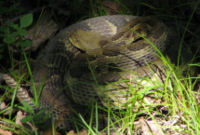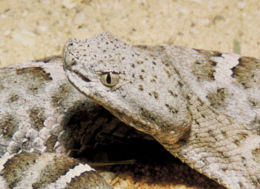| Crotalinae | ||||||||||||||||
|---|---|---|---|---|---|---|---|---|---|---|---|---|---|---|---|---|

Timber rattlesnake,
Crotalus horridus
|
||||||||||||||||
| Scientific classification | ||||||||||||||||
|
||||||||||||||||
|
Common names: pit-vipers.
The Crotalinae, or crotalines, are a subfamily of venomous vipers. They are distinguished by their heat-sensing pit organs located between the eye and the nostril on either side of the head. 18 genera are currently recognized:[2] 7 in the Old World and 11 in the New World.[1] These are the only viperids found in the Americas.
Contents |
Description
Like all viperids, pit vipers all have a pair of relatively long, solenoglyphous (hollow) fangs that are used to inject mainly proteotoxic venom. The head has an obvious triangular shape and eyes have elliptical pupils. For further information, see Viperidae.

Pit vipers are named after their specialized thermoreceptors: heat-sensitive organs located on either side of the head that look like small pits. These pits contain membranes sensitive to infrared radiation and allows the snakes to locate their prey based on temperature differences with their environment. To a pit viper, rodents and birds that are only fractionally warmer than the background stand out even in complete darkness. Like a primitive pair of eyes, these pits even give them depth perception, allowing them to strike accurately under such conditions. Since the crotalines, like most other viperids, are nocturnal ambush predators, this adaptation serves them particularly well. In an example of parallel evolution, only the boids have developed similar heat-sensitive organs.
Crotalines range in size from small, such as the eyelash viper, Bothriechis schlegelii, with a maximum of 50 cm (20 inches), to the bushmaster, Lachesis muta, that grows to an imposing 3.5 metres (11.5 feet) and is the longest viper in the world.
Geographic range
This family of snakes is found in the Old World from eastern Europe eastward through Asia to Japan, Taiwan, Indonesia, peninsular India and Sri Lanka. In the Americas, they range from southern Canada southward through Mexico and Central America to southern South America.[1]
Habitat
Pit Vipers are a versatile group, with members found in habitats ranging from parched desert (e.g., rattlesnakes) to rainforests (e.g., the fer-de-lance, Bothrops atrox) and even aquatic settings (e.g., the water moccasin, Agkistrodon piscivorus). Species may be either arboreal or terrestrial, and some can even be found at elevations exceeding 1,000 metres.
Behavior
Although a few species are highly active by day, such as Trimeresurus trigonocephalus, a bright green pit viper endemic to Sri Lanka, most are nocturnal, preferring to avoid scorching daytime temperatures and to hunt when their favored prey are also active. The snakes' heat-sensitive pits are also thought to aid in locating cooler areas in which to rest.
As ambush predators, crotalines will typically wait patiently somewhere for unsuspecting prey to wander by. At least one species, the arboreal Gloydius shedaoensis of China, is known to select a specific ambush site and return to it every year in time for the spring migration of birds. Studies have indicated that these snakes learn to improve their strike accuracy over time.[3]
Many temperate species (e.g. most rattlesnakes) will congregate in sheltered areas or dens to overwinter (see hibernation), the snakes benefitting from the combined heat. In cool temperatures and while pregnant vipers also bask on sunny ledges. Some species do not mass together in this way, such as the copperheads, Agkistrodon contortrix, and the Mojave rattlesnake, Crotalus scutulatus.
Like most snakes, crotalines keep to themselves and will strike only if cornered or threatened. Smaller snakes are less likely to stand their ground than are larger specimens. Pollution and the destruction of rainforests has caused many viper populations to decline. Humans also threaten vipers, as many vipers are hunted for their skins or killed by cars when they wander onto roads.
Reproduction
With few exceptions, crotalines are ovoviviparous; that is, females give birth to live young. Among the oviparous (egg-laying) pit vipers are Lachesis, Calloselasma, and some Trimeresurus species. It is believed that all egg-laying crotalines guard their eggs.
Brood sizes range from two for very small species, to as many as 86 for the fer-de-lance, Bothrops atrox: a species among the most prolific of all live-bearing snakes. Many young crotalines have brightly coloured tails that contrast dramatically with the rest of their bodies. Used in a behavior known as caudal luring, the young snakes make worm-like movements with their tails to lure unsuspecting prey within striking distance.
Genera
| Genus[2] | Authority[2] | Species[2] | Subsp.*[2] | Common name | Geographic range[1] |
|---|---|---|---|---|---|
| Agkistrodon | Palisot de Beauvois, 1799 | 3 | 9 | Moccasins | North America from the northeastern and central USA southward through peninsular Florida and southwestern Texas. In Central America on the Atlantic versant from Tamaulipas and Nuevo León southward to the Yucatan Peninsula, Belize and Guatamala. Along the Pacific coastal plane and lower foothills from Sonora south through Guatamala, El Salvador, Honduras and Nicaragua to northwestern Costa Rica. |
| Atropoides | Werman, 1992 | 3 | 2 | Jumping vipers | The mountains of eastern Mexico southeastward on the Atlantic versant and lowlands though Central America to central Panama. On the Pacific versant, they occur in isolated populations in east-central and southern Mexico, Guatamala, El Salvador, Costa Rica and Panama. |
| Bothriechis | Peters, 1859 | 7 | 0 | Palm vipers | Southern Mexico (southeastern Oaxacaand the northern highlands of Chiapas), through Central America to northern South America (Colombia, western Venezuela, Ecuador and northern Peru. |
| Bothriopsis | Peters, 1861 | 7 | 2 | Forest vipers | Eastern Panama and most of northern South America, including the Pacific lowlands of Colombia and Ecuador, the Andes Mountains from Venezuela and Colombia to Bolivia, the Amazon Basin and the Atlantic forests of Brazil. |
| Bothrops | Wagler, 1824 | 32 | 11 | Lanceheads | Northeastern Mexico (Tamaulipas) southward through Central and South America to Argentina; Saint Lucia and Martinique in the Lesser Antilles; Ilha da Queimada Grande off the coast of Brazil. |
| Calloselasma | Cope, 1860 | 1 | 0 | Malayan pit viper | Southeast Asia from Thailand to northern Malaysia and Java, Indonesia. |
| Cerrophidion | Campbell & Lamar, 1992 | 3 | 0 | Montane pit vipers | Southern Mexico (highlands of Guerrero and southeastern Oaxaca), southward through the highlands of Central America (Guatamala, El Salvador, Honduras, northern Nicaragua, Costa Rica) to western Panama. |
| CrotalusT | Linnaeus, 1758 | 27 | 43 | Rattlesnakes | The Americas, from southern Canada to northern Argentina. |
| Deinagkistrodon | Gloyd, 1979 | 1 | 0 | Hundred-pace viper | Southeast Asia. |
| Gloydius | Hoge & Romano-Hoge, 1981 | 9 | 9 | Russia, east of the Ural Mountains through Siberia, Iran, the Himalayas from Pakistan, India, Nepal and China, Korea, Japan and the Ryukyu Islands. | |
| Hypnale | Fitzinger, 1843 | 3 | 0 | Humpnose vipers | Sri Lanka and India. |
| Lachesis | Daudin, 1803 | 3 | 1 | Bushmasters | Central and South America. |
| Ophryacus | Cope, 1887 | 2 | 0 | Mexican pit vipers | Mexico. |
| Ovophis | Burger, 1981 | 3 | 3 | Asian mountain vipers and South Asian pit vipers | Nepal and Seven Sisters (Assam) eastward through Myanmar, Cambodia, Thailand, Laos, Vietnam, West Malaysia, Taiwan, Japan (Okinawa) and Indonesia (Sumatra and Borneo). |
| Porthidium | Cope, 1871 | 7 | 3 | Hognose pit vipers | Mexico (Colima, Oaxaca and Chiapas on the Pacific side, the Yucatan Peninsula on the Atlantic side) southward through Central America to northern South America (Ecuador in the Pacific lowlands, northern Venezuela in the Atlantic lowlands). |
| Sistrurus | Garman, 1883 | 3 | 7 | Massasaugas and pigmy rattlesnakes | Southeastern Canada, eastern and northwestern USA, isolated populations in northern and central Mexico. |
| Trimeresurus | Lacépède, 1804 | 35 | 11 | Asian pit vipers and palm vipers | Southest Asia from India to southern China and Japan, and the Malay Archipelago to Timor. |
| Tropidolaemus | Wagler, 1830 | 2 | 0 | Temple vipers | Southern India and Southeast Asia. |
*) Not including the nominate subspecies (typical
form).
T)
Type genus.[1]
Taxonomy
In the past, the pit vipers were usually classed as a separate family: the Crotalidae. Today, however, the monophyly of the viperines and the crotalines as a whole is undisputed, which is why they are treated here as a subfamily of the Viperidae.
See also
Cited references
- ^ a b c d e McDiarmid RW, Campbell JA, Touré T. 1999. Snake Species of the World: A Taxonomic and Geographic Reference, vol. 1. Herpetologists' League. 511 pp. ISBN 1-893777-00-6 (series). ISBN 1-893777-01-4 (volume).
- ^ a b c d e Crotalinae (TSN 634394). Integrated Taxonomic Information System. Accessed on 26 October 2006.
- ^ Shine R, Sun L, Kearney M, Fitzgerald M. 2002. Why do Juvenile Chinese Pit-Vipers (Gloydius shedoaensis) Select Arboreal Ambush Sites? Ethology 108:897-910. ISSN 0179-1613. PDF at University of Sydney School of Biological Sciences. Accessed 26 October 2006.
Other references
- Gumprecht, A. & F. Tillack (2004) A proposal for a replacement name of the snake genus Ermia Zhang, 1993. Russian Journal of Herpetology 11: 73-76.
- Wright & Wright (1957), Handbook of Snakes Volume II, Comstock Publishing Associates, Seventh Printing 1985.